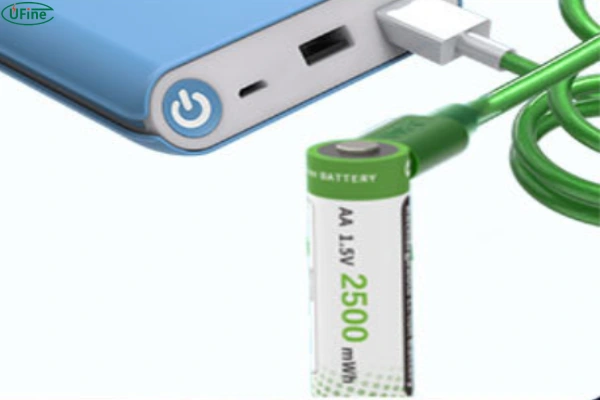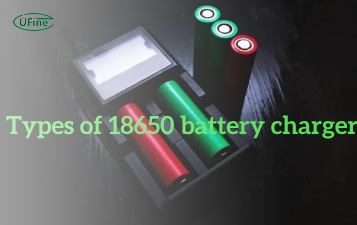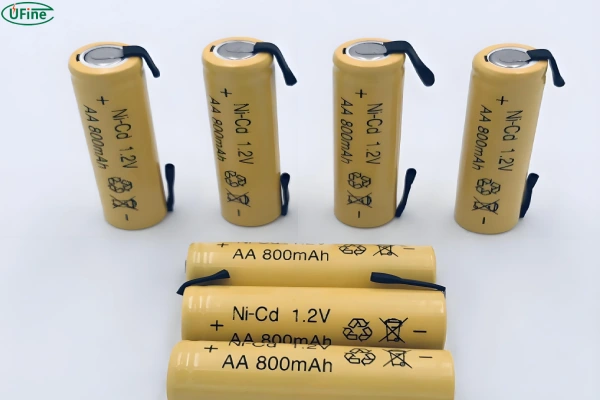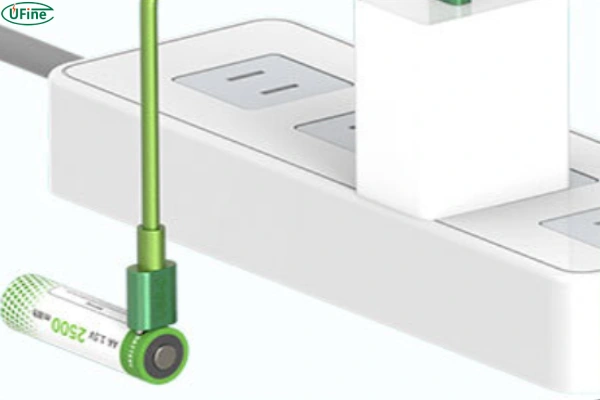
- Part 1. What are AA rechargeable batteries?
- Part 2. Types of AA rechargeable batteries
- Part 3. Which rechargeable AA batteries are best?
- Part 4. Key parameters to consider
- Part 5. Where are AA rechargeable batteries used?
- Part 6. How long do AA rechargeable batteries last?
- Part 7. How to charge AA rechargeable battery?
- Part 8. Final words
AA rechargeable batteries are more than just convenient power sources. They represent a shift toward sustainability, cost-efficiency, and reliability. Whether you’re powering a child’s toy, keeping a flashlight ready for emergencies, or maintaining constant power for your wireless mouse, AA rechargeable batteries ensure that you never run out of juice when you need it most. In this article, we’ll take an in-depth look at AA rechargeable batteries, how they work, and why they’ve become an essential part of modern life. You’ll discover the types, best applications, and tips to keep these batteries performing at their best.
Part 1. What are AA rechargeable batteries?

AA rechargeable batteries are standard-sized, reusable batteries that can be charged and discharged multiple times. They’re cylindrical in shape, measuring approximately 50.5mm in length and 14.5mm in diameter, making them compatible with a wide range of everyday devices. Unlike disposable AA batteries, which lose their power after a single use, rechargeable AA batteries can be used hundreds or even thousands of times, making them an economical and eco-friendly choice.
Think of all the remote controls in your house, the gaming controllers, or the wireless keyboard you use for work. Every time the battery runs out, you reach for a new one. Now imagine the convenience of simply recharging the same battery over and over again. That’s the power and reliability of AA rechargeable batteries—you don’t just buy power, you invest in it.
Part 2. Types of AA rechargeable batteries
AA rechargeable batteries come in several types, and each has unique chemistry, performance characteristics, and ideal use cases. Understanding these types can help you make an informed choice:
-
Nickel-Metal Hydride (NiMH): By far the most common type, NiMH batteries are a perfect blend of performance and capacity. They have no memory effect, meaning you don’t have to worry about losing capacity if you recharge them before they are fully discharged. They can hold anywhere between 2000 to 2800mAh, making them ideal for high-drain devices like digital cameras, gaming controllers, and flashlights. For families who constantly power multiple devices, NiMH batteries can save a significant amount of money over time.
-
Nickel-Cadmium (NiCd): These are older batteries with a lower capacity than NiMH, usually ranging between 600 and 1000mAh. While they can endure more extreme temperatures and have a longer lifespan in specific conditions, they are prone to the memory effect, which reduces their capacity if not fully discharged before recharging. Though their use has diminished due to environmental concerns, NiCd batteries are still reliable for emergency lighting and low-drain devices.
-
Lithium-Ion (Li-ion): While less common in AA size, Li-ion rechargeable batteries offer the highest energy density, providing more power in a smaller, lighter package. They can last much longer between charges, which is why they are preferred for high-energy devices like advanced cameras and medical equipment. However, they are more expensive and require specialized chargers.
NiMH Battery vs Li-Ion Battery vs NiCad Battery: How are they different?
Part 3. Which rechargeable AA batteries are best?
The “best” AA rechargeable battery largely depends on your needs. However, NiMH batteries are widely considered the most versatile and cost-effective option for the average user. Their combination of high capacity, long cycle life, and minimal memory effect makes them suitable for nearly all household devices. For example, if you’re a parent with children who love electronic toys, NiMH batteries can save you from constantly replacing dead batteries.
For those using higher-end devices like cameras or professional audio equipment, Li-ion batteries may be worth the investment due to their longer runtime and lightweight design.
Part 4. Key parameters to consider
Choosing the right AA rechargeable battery requires understanding some key parameters that affect performance:
-
Capacity (mAh): Capacity refers to how much charge a battery can hold, measured in milliampere-hours (mAh). The higher the capacity, the longer the battery will last on a single charge. For most household devices, a capacity of 2000 to 2800mAh is ideal. Imagine using high-drain devices like flashlights or cameras—higher capacity batteries will give you more runtime, reducing the need to recharge frequently.
-
Voltage: AA rechargeable batteries usually operate at 1.2V, slightly lower than the 1.5V of disposable alkaline batteries. Although this may seem like a downside, most devices are designed to operate efficiently with 1.2V, and the steady discharge of NiMH batteries often results in better overall performance compared to alkaline counterparts, which lose power more rapidly.
-
Cycle Life: Cycle life indicates how many times a battery can be recharged before its performance declines. Most NiMH batteries have a cycle life of 500 to 1000 cycles. Imagine only having to replace your batteries once every few years even after hundreds of charges—that’s the durability cycle life offers.
-
Self-discharge Rate: Some AA rechargeable batteries lose their charge when not in use, known as self-discharge. Low self-discharge NiMH batteries are designed to retain their charge longer, even when stored for months. This feature is ideal for infrequently used devices like emergency flashlights.
Part 5. Where are AA rechargeable batteries used?
AA rechargeable batteries are remarkably versatile, making them useful in a wide variety of devices:
- Digital Cameras: Keep your camera powered during long trips without constantly swapping out disposable batteries.
- Gaming Controllers: Enjoy uninterrupted gaming with high-capacity AA rechargeable batteries.
- Remote Controls: Perfect for remotes, especially in households with multiple TVs or entertainment systems.
- Toys: Ideal for powering children’s toys, ensuring they last longer between charges, and saving parents money in the long run.
- Wireless Keyboards and Mice: Perfect for office or home use, rechargeable batteries keep wireless devices functional for months on end.
- Portable Radios: Never lose access to your favorite radio stations, whether camping or during a power outage.
- Flashlights: Reliable, long-lasting power is essential for flashlights, especially in emergency situations.
Part 6. How long do AA rechargeable batteries last?
The lifespan of AA rechargeable batteries varies depending on the type and usage. NiMH batteries can last anywhere between 3 to 5 years, or up to 1000 charging cycles. If you’re using them in low-drain devices, such as a wall clock or remote control, the battery could last for several months on a single charge. For higher-drain devices like cameras, the battery life may be shorter per charge, but the overall cost savings and reduced waste are well worth it. Over time, a reliable set of AA rechargeable batteries can replace hundreds of disposable ones.
Part 7. How to charge AA rechargeable battery?
Charging AA rechargeable batteries is simple, but here are some essential tips to ensure you get the most out of your batteries:
-
Use the Right Charger: Always use a charger that is specifically designed for your type of AA battery, whether NiMH or Li-ion. Some chargers are smart and prevent overcharging, extending the life of your batteries.
-
Avoid Overcharging: Though many modern chargers automatically shut off when the battery is full, it’s still a good practice to remove the batteries after they’re done charging to avoid overheating.
-
Store in a Cool Place: Heat is one of the biggest enemies of battery longevity. Charge and store your batteries in a cool, dry place to prevent degradation.
Part 8. Final words
AA rechargeable batteries are more than just a convenient power solution—they are an investment in sustainability, cost-efficiency, and performance. Whether you’re powering everyday devices or high-performance electronics, these batteries can save you time, money, and the hassle of constantly replacing disposables. Choose the right type, care for them properly, and you’ll enjoy years of reliable energy from your AA rechargeable batteries.
Related Tags:
More Articles

Learn how to safely recharge 18650 batteries, choose the best 18650 battery charger, and extend battery life with expert tips and practical strategies.
12 Volt Batteries: How Long Can They Really Last?
Discover the real lifespan of 12V batteries. Compare lead-acid, AGM, gel, and lithium (LiFePO₄) batteries — and find out why LiFePO₄ lasts over 10 years.
Lithium-ion vs Lithium Polymer Battery: Which is Better?
Compare Li-ion and LiPo batteries in energy, safety, lifespan, and uses. Learn which battery is best for drones, laptops, and wearables.
Power Pack Battery vs. Power Bank: What’s the Difference?
Compare power pack battery and power bank: capacity, devices, portability, and best uses to pick the right portable battery pack.
12V STD vs 12V AGM: Meaning, Differences, and Which Is Better
Understand what STD and AGM batteries mean, their key differences, and which 12V battery fits your needs best in 2025.




